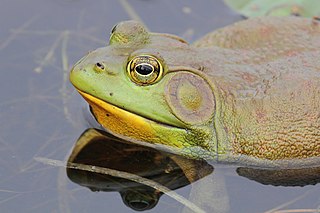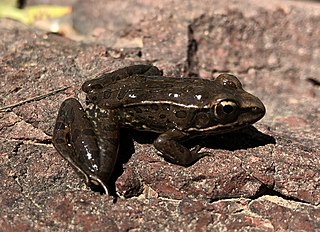
The Necaxa River is one of the main rivers of the Mexican state of Puebla. It is a tributary of the Tecolutla River. Beginning south of Huauchinango with the name Totolapa, it runs through tall mountains and deep canyons of the Sierra Madre Oriental, forming the waterfalls known as Salto Chico y Salto Grande. Its flow is also used to generate hydroelectric power.

Lithobates is a genus of true frogs, of the family Ranidae. The name is derived from litho- (stone) and the Greek bates, meaning one that treads on rock, or rock climber.
Craugastor mexicanus is a species of frog in the family Craugastoridae. It is endemic to eastern Mexico and occurs in the states of Oaxaca, Puebla, Hidalgo, and Veracruz. It is a common species inhabiting tropical wet and semi-deciduous forest, pine-oak montane forest, and montane cloud forest at elevations of 700–3,420 m (2,300–11,220 ft) above sea level. Although it is adaptable to habitat disturbance, loss of cloud forest is a potential threat to it. Also chytridiomycosis can have negative impacts. It is present in a number of protected areas, including Cofre de Perote National Park, Tehuacán-Cuicatlán Biosphere Reserve, and Cuenca Hidrográfica Río Necaxa.
The Rio Chipillico frog is a species of frog in the family Ranidae, found in Ecuador and Peru. Its natural habitats are tropical forests near fast-flowing rivers; it breeds in pools of water near rivers. It is threatened by habitat loss caused by agricultural expansion and human settlement.

The gopher frog is a species of frog in the family Ranidae, endemic to the south-eastern United States. It primarily inhabits the threatened sandhill communities, flatwoods, and scrub in the Atlantic coastal plain, where it is usually found near ponds.
The Lago de las Minas frog is a species of frog in the family Ranidae. It is endemic to the Las Minas Lake in the Oriental Basin of Puebla, Mexico. Its natural habitat is vegetation surrounding the lake. It is threatened by deterioration in the quality of habitat surrounding the lake as well as the decline in lake surface level caused by groundwater extraction.
The Maya Mountains frog is a species of frog in the family Ranidae found in Belize and possibly Guatemala. Its natural habitats are subtropical or tropical moist lowland forests, moist savanna, and rivers. This anuran is found primarily in the Mayan Mountain region between 100m and 915m of elevation.
Lemos-Espinal's leopard frog is a species of frog in the family Ranidae endemic to the Sierra Madre Occidental of southwestern Chihuahua in northern Mexico. Its natural habitats are pine-oak forests. It is threatened by habitat loss.

The highland frog, also known as the masked mountain frog, is a species of frog in the family Ranidae, known from El Salvador, Guatemala, Honduras, Mexico, and Nicaragua. Its natural habitats are subtropical or tropical moist lowland forests, subtropical or tropical moist montane forests, rivers, and freshwater marshes. It is threatened by habitat loss.
The big-footed leopard frog or bigfoot leopard frog, is a species of frog in the family Ranidae endemic to western central Mexico where it is found in the Nayarit, Jalisco, Michoacan, and Guanajuato states.

The Montezuma leopard frog is a species of frog in the family Ranidae endemic to Mexico. Its natural habitats are pine-oak or oak forests above 2,000 m (6,600 ft) asl but it can also survive in moderately altered habitats. It breeds in lakes and big pools. It is potentially threatened by habitat loss and introduced predators. It is also collected for human consumption.

The transverse volcanic leopard frog is a species of frog in the family Ranidae endemic to the southern edge of the Mexican Plateau, Mexico. Its natural habitats are pine-oak forests and mesquite grasslands near lakes, pools or slow-flowing streams. It is threatened by habitat loss.

The relict leopard frog is a species of frog in the family Ranidae, endemic to the United States. It is found along the Colorado river in extreme northwestern Arizona, and adjacent Nevada and southwestern Utah, although its present range seems to be restricted to the Lake Mead National Recreation Area. Its natural habitat is freshwater springs and their outlets. It is threatened by habitat loss to agriculture and water development as well as invasive species.
The smooth-backed frog is a species of frog in the family Ranidae endemic to Mexico.
The Sierra Madre frog is a species of frog in the family Ranidae endemic to the Sierra Madre del Sur in Guerrero and Oaxaca states, Mexico. Its local name is rana de Sierra Madre Occidental. Its natural habitats are conifer forests at intermediate elevations. Breeding takes place in streams. It is threatened by habitat loss (logging) and possibly chytridiomycosis.

The Tarahumara frog is a species of frog in the family Ranidae found in Mexico and—formerly—the United States, where it is now regionally extinct. Its natural habitats are streams and plunge pools in canyons in oak and pine-oak woodland, and foothill thorn scrub and tropical deciduous forest in the Pacific coast tropical area. Permanent water is necessary for reproduction.

Vaillant's frog is a species of frog in the family Ranidae found in Central America. Its natural habitats are subtropical or tropical dry forests, subtropical or tropical moist lowland forests, subtropical or tropical swamps, rivers, swamps, freshwater lakes, intermittent freshwater lakes, freshwater marshes, intermittent freshwater marshes, rural gardens, heavily degraded former forests, water storage areas, ponds, and canals and ditches.
Lithobates vibicarius, commonly known as either green-eyed frog or Rancho Redondo frog, is a species of frog in the family Ranidae from highland rainforests in Costa Rica and western Panama.

The carpenter frog is a species of true frog found on coastal plain of the Atlantic coast of the United States between central New Jersey and northeastern Florida.

Zweifel's frog is an amphibian species endemic to Mexico. It is a member of the true frog family, Ranidae.











